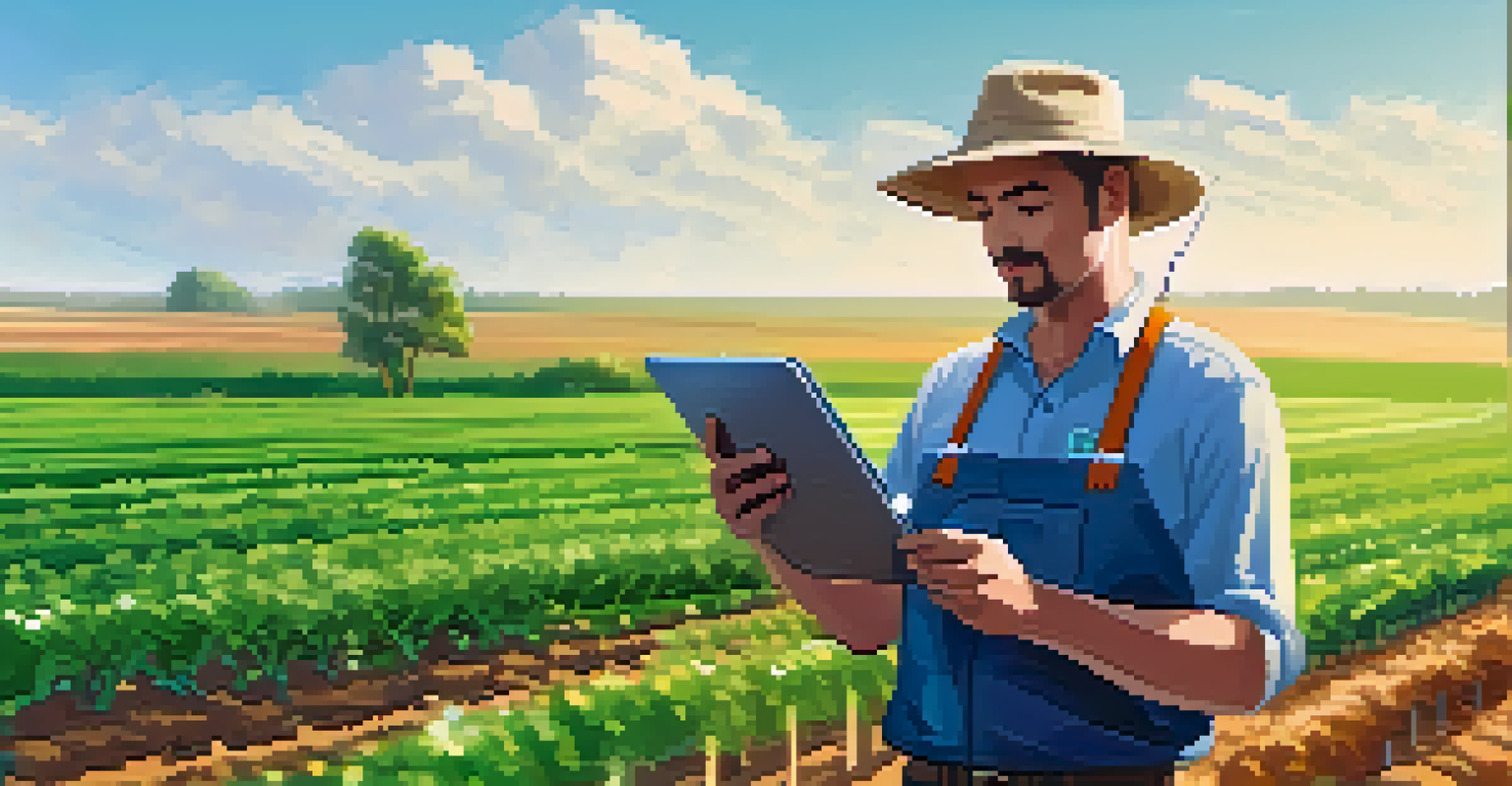The Evolution of IoT: From Concept to Widespread Adoption

Understanding the Basics of IoT: What Is It Really?
The Internet of Things (IoT) refers to a network of interconnected devices that communicate and exchange data. Imagine your coffee maker sending a notification to your smartphone when the brew is ready; that's IoT in action. This concept goes beyond just smart appliances; it encompasses everything from wearable fitness trackers to smart city infrastructure.
The Internet of Things is not a concept; it is a way of life.
At its core, IoT aims to enhance everyday experiences by making devices smarter and more responsive. By embedding sensors and software, these devices can collect and analyze data, leading to improved efficiency and convenience. Think of it as giving everyday objects a voice, allowing them to connect with each other and with us.
The evolution of IoT relies on advancements in technology, such as cloud computing and machine learning. These innovations empower devices to learn from data patterns, making them not just reactive but proactive. As we delve deeper into IoT, it’s essential to understand the foundational elements that paved the way for its growth.
The Early Days: Conceptualization of IoT
The idea of connecting devices dates back to the early 1980s when a toaster was modified to be connected to the internet. This quirky experiment was one of the first glimpses into what IoT could become. However, it wasn't until the mid-2000s that the term 'Internet of Things' was officially coined by Kevin Ashton, a technology pioneer.

In those early days, IoT was largely a concept limited to research and development within tech labs. The potential was recognized, but the infrastructure and technology to support widespread implementation were still in their infancy. It was a time of dreaming big, where the possibilities seemed endless but were not yet realized.
IoT Enhances Everyday Experiences
The Internet of Things connects devices to improve efficiency and convenience in daily life.
Despite the slow start, these foundational ideas sparked a movement, leading to increased interest and investment in IoT. As businesses began to see the benefits of connected devices, the groundwork was laid for future innovations. This period set the stage for the rapid advancements that would follow.
Technological Advancements Fueling IoT Growth
The explosion of IoT can be attributed to significant technological advancements, particularly in wireless communication and sensor technology. The advent of Wi-Fi, Bluetooth, and cellular networks enabled devices to connect seamlessly over the internet. Imagine a world where your fridge can alert you when you're low on groceries—this became possible thanks to these innovations.
The real power of the Internet of Things is not in the things themselves but in the connections between them.
Moreover, the dramatic decrease in the cost of sensors and microcontrollers made it feasible for manufacturers to embed IoT capabilities in a wide range of products. These tiny components, once expensive, are now affordable and accessible, allowing even everyday items to become 'smart.' This democratization of technology has opened the floodgates for IoT applications.
Cloud computing also plays a critical role in IoT's success by providing the necessary computing power and storage to process vast amounts of data generated by connected devices. With data stored and analyzed in the cloud, businesses can gain insights and improve decision-making processes, paving the way for smarter operations.
Real-World Applications: How IoT is Transforming Industries
IoT has found its way into various industries, revolutionizing how we work and live. In healthcare, for instance, wearable devices monitor patient vitals in real-time, allowing for proactive care and reducing hospital visits. Imagine a heart monitor that alerts doctors immediately if something goes wrong—that’s the power of IoT in action.
In agriculture, IoT technology enables farmers to monitor soil conditions and crop health, optimizing yields and reducing waste. Smart irrigation systems can detect moisture levels and water crops accordingly, conserving resources and increasing efficiency. These applications demonstrate IoT's potential to improve productivity across sectors.
Technological Growth Drives IoT
Advancements in wireless communication and cloud computing are key to the rapid expansion of IoT applications.
Even in transportation, IoT is making waves with connected vehicles that communicate with each other and traffic systems. This not only enhances safety by reducing accidents but also streamlines traffic flow, reducing congestion. The real-world impact of IoT is profound, showcasing its ability to enhance various aspects of our lives.
Challenges in IoT: Security and Privacy Concerns
As IoT continues to expand, it brings with it a host of challenges, particularly regarding security and privacy. With more devices connected to the internet, the potential for cyberattacks increases. For instance, if a hacker gains access to a smart home system, they could manipulate devices or harvest personal data, leading to serious security breaches.
Privacy concerns also arise as IoT devices collect vast amounts of personal data. Many consumers are unaware of the extent to which their information is being tracked and used. This lack of transparency can lead to distrust, highlighting the need for clear communication and robust security measures from manufacturers.
To address these challenges, the industry is working on developing better security protocols and privacy regulations. As consumers become more educated about IoT, they will demand safer, more transparent devices. Striking the right balance between innovation and security is crucial for the continued growth of IoT.
The Future of IoT: Trends to Watch
Looking ahead, several trends are poised to shape the future of IoT. One significant trend is the rise of edge computing, which processes data closer to where it's generated rather than relying solely on the cloud. This can enhance speed and reduce latency, making IoT applications more efficient—think of it as having a quick-thinking assistant that helps you make decisions in real-time.
Another trend is the increasing integration of artificial intelligence (AI) into IoT systems. By leveraging AI, devices can learn from data patterns and make smart decisions without human intervention. This is like having a smart assistant who not only helps you but also anticipates your needs before you even ask.
Security Challenges in IoT
As IoT grows, the importance of addressing security and privacy concerns becomes increasingly critical.
Finally, as sustainability becomes a global priority, IoT will play a crucial role in promoting environmentally friendly practices. Smart grids and connected energy systems can optimize energy usage, reducing waste and lowering carbon footprints. The future of IoT is bright, with the potential to create a more efficient and sustainable world.
Conclusion: Embracing the IoT Revolution
In summary, the evolution of IoT from a simple concept to a transformative force has been nothing short of remarkable. As we embrace this technology, it offers numerous opportunities to enhance our lives, from smarter homes to more efficient industries. However, alongside these opportunities come challenges that must be addressed to ensure a secure and trustworthy environment.
The journey of IoT is far from over; it's continuously evolving, driven by technological advancements and the increasing demand for connectivity. As we look to the future, we must stay informed and proactive in embracing IoT, ensuring that it serves our needs while protecting our security and privacy.

Ultimately, the key to fully harnessing the power of IoT lies in collaboration—between manufacturers, consumers, and regulators. By working together, we can navigate the complexities of this technology, paving the way for a smarter, more connected world.